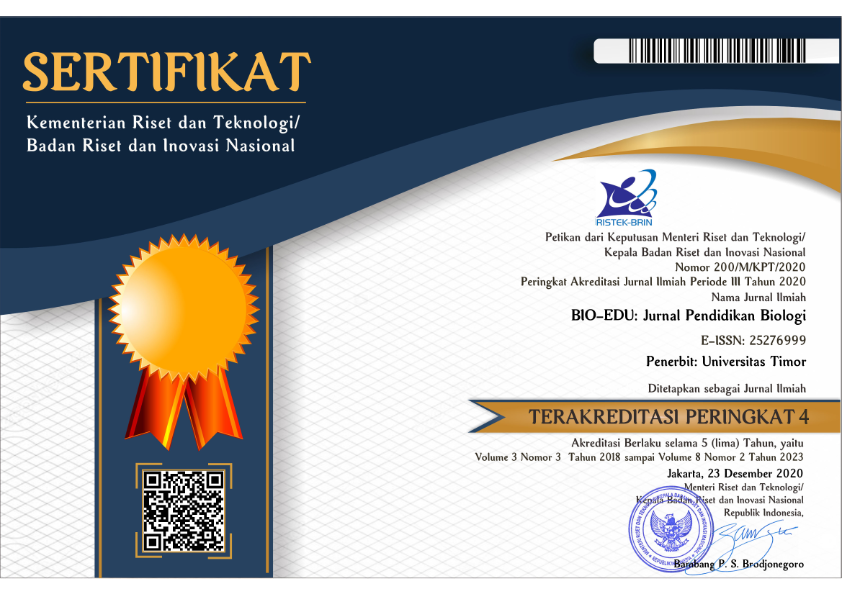Etnobotani Tumbuhan Obat Tradisional di Desa Huilelot dan Desa Uiasa Kecamatan Semau Kabupaten Kupang
DOI:
https://doi.org/10.32938/jbe.v6i1.993Keywords:
Etnobotani, tumbuhan berkasiat obat, Desa Huilelot, Desa UiasaAbstract
Abstract
The Communities in Huilelot and Uiasa Village have the knowledge of traditional medicine by using various types of plants that have medicinal ingridient around them starting from the yard of the house, garden, roadside to the forest. From the Information obtained, this study was aim to determine the types of plants that have medicinal ingridient, medicinal parts/organs of medicinal properties, methods of treatment, diseases that are cured by using medicinal plants by the community and the cultivation of medicinal plants in Huilelot and Uiasa village. This research was conducted in October - November 2017. The method used in this study was roaming, while sampling and data collection of medicinal plants was carried out by exploration methods around the site. The Work procedures include preparation consisting of observation, determination of informants, and preparing tools and research materials. The implementation phase consists of interviews, exploration and documentation and identification. The data analysis technique used was descriptive analysis, which was presented in the form of a table then matches plants with images or examples according to the source of the literature. Based on the results of the study, 31 types of plants with medicinal properties were used by the community. Plant organs used were leaves, stems, fruits, seeds, tubers, roots and all organs. The most widely used part is leaves. The method of concocting is boiling, pounding, chewing, eating directly, trimming, blending and boiling. Most of mixing methode used was boiled. Diseases that can be cured include high blood pressure, blood sugar, intestines, scabies, liver, abdominal pain, hernias, stomach, vaginal discharge, goiter, malaria and heat, uterine tumors, cancer and breast tumors, pain during childbirth, rheumatism, kidney, urine stones, diabetes, myopic eyes, cuts, bleeding, and broken bones or accidents. From the results of the study there were 12 species cultivated at home and in the garden, while 19 other species grew wild (sabana) or not cultivated by the community
Downloads
Published
Issue
Section
License
The Authors submitting a manuscript do so on the understanding that if accepted for publication, the copyright of the article shall be assigned to BIO-EDU: Jurnal Pendidikan Biologi and Departement of Biology Education, Universitas Timor as the publisher of the journal. Copyright encompasses rights to reproduce and deliver the article in all form and media, including reprints, photographs, microfilms, and any other similar reproductions, as well as translations.
BIO-EDU journal and Departement Biology Education, Universitas Timor, and the Editors make every effort to ensure that no wrong or misleading data, opinions, or statements be published in the journal. In any way, the contents of the articles and advertisements published in BIO-EDU are the sole and responsibility of their respective authors and advertisers.
Users of this website will be licensed to use materials from this website following the Creative Commons Attribution-ShareAlike 4.0 International License.



















